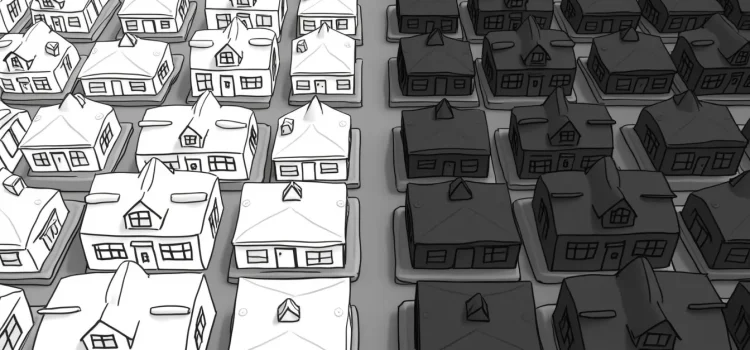

This article is an excerpt from the Shortform book guide to "Mediocre" by Ijeoma Oluo. Shortform has the world's best summaries and analyses of books you should be reading.
Like this article? Sign up for a free trial here.
What are the long-lasting effects of housing segregation in America? Why did such a practice happen?
In an exploration of white supremacy, Ijeoma Oluo dives into the history and consequences of housing segregation in the US. She examines how this practice emerged and how it continues to impact wealth distribution, urban landscapes, and social dynamics today.
Keep reading to understand the ins and outs of housing segregation.
Housing Segregation
Oluo contends that, when women and people of color gain a foothold in the arenas that were once exclusively the domain of white men, white men push back. One way they do this is by seeking to limit the scope of the progress. She provides the example of housing segregation.
This came about after Black people began competing for industrial jobs in the northern US after the end of the Civil War. Following the abolition of slavery, much of the South’s Black population migrated north to escape growing attempts to suppress their newly won civil rights. Oluo says that white northerners resented this influx of new job competitors and initially reacted with racist violence, as when a series of anti-Black riots swept through a number of cities in 1919.
(Shortform note: This rash of violence in 1919 was only the latest in a long line of tactics—some violent, some legislative—designed to restrict Black people’s rights following the Civil War. In fact, the period ranging from roughly the late 1870s through the early 1920s is sometimes referred to as the “nadir” of race relations in the US because of the prevalence of voter suppression, lynchings, Jim Crow segregation laws, and mainstream racist propaganda during this time.)
Eventually, Oluo says, to protect their sense of white identity and to limit Black wealth and influence, many cities began adopting racially restrictive housing covenants—rules that prevent the sale or rental of a given property to people of color. According to Oluo, these covenants have had several long-term effects:
- They prevent many Black people from buying homes, which limits their prospects for building long-term, inheritable wealth and contributes to a racial wealth gap that persists today.
- They segregate cities into white and Black neighborhoods. Typically, Black people only have access to poorer, more crowded areas with fewer municipal services. This imposed poverty leads to worse outcomes and limits Black economic and political power.
- They make cities’ Black populations less visible, which allows white residents to benefit from Black economic contributions without having to encounter Black people much of the time—thus preserving the illusion of white exclusivity so central to white identity.
- They subject Black neighborhoods to racist policing that sometimes results in the needless deaths of Black citizens.
(Shortform note: In Stamped From the Beginning, Kendi adds that housing segregation also leads to a new racist belief: the myth of the pathological Black family. According to this myth, social and economic problems in Black communities result from Black people’s inability to form cohesive, functional family units—and so they live in poor, crime-ridden neighborhoods because they’re incapable of anything else. Not only does this myth elide the role that racist policies like housing segregation play in creating problems like poverty, but it also exacerbates these problems by subjecting Black communities to further forms of discrimination such as redlining (being denied important services such as mortgages, insurance, and grocery stores).)

———End of Preview———
Like what you just read? Read the rest of the world's best book summary and analysis of Ijeoma Oluo's "Mediocre" at Shortform.
Here's what you'll find in our full Mediocre summary:
- Why underqualified white men are in powerful positions
- How toxic white men have reacted to social progress
- The presence of white supremacy in American football






